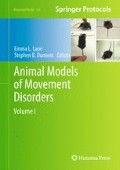Abstract
Neurodegeneration is largely limited to humans, with spontaneous neurodegenerative conditions being extremely rare in animals. However, whole animal models are crucial for a proper understanding of the neurodegenerative process as well as essential for preclinical assessment of novel therapies. Thus, it has been necessary to generate animal models of neurodegeneration using a combination of techniques, including injectable toxins and genetic manipulation. Given the constraints inherent in these approaches, how successful are animal models of neurodegeneration and how can such models be refined in the future?
Access this chapter
Tax calculation will be finalised at checkout
Purchases are for personal use only
References
Massion J (1988) Red nucleus: past and future. Behav Brain Res 28: 1–8
de Oliveira RM, Pais TF, Outeiro TF (2010) Sirtuins: common targets in aging and in neurodegeneration. Curr Drug Targets 11: 1270–80
Whitworth AJ (2011) Drosophila models of Parkinson’s disease. Adv Genet 73: 1–50
Brooks SP, Janghra N, Workman VL, Bayram-Weston Z, Jones L, Dunnett SB (2011) Longitudinal analysis of the behavioural phenotype in R6/1 (C57BL/6J) Huntington’s disease transgenic mice. Brain Res Bull, in press
Klein A, Sacrey LA, Dunnett SB, Whishaw IQ, Nikkhah G (2011) Proximal movements compensate for distal forelimb movement impairments in a reach-to-eat task in Huntington’s disease: new insights into motor impairments in a real-world skill. Neurobiol Dis, in press
Venda LL, Cragg SJ, Buchman VL, Wade-Martins R (2010) α-Synuclein and dopamine at the crossroads of Parkinson’s disease. Trends Neurosci 33: 559–68
Magen I, Chesselet MF (2010) Genetic mouse models of Parkinson’s disease: The state of the art. Prog Brain Res 184: 53–87
Dawson TM, Ko HS, Dawson VL (2010) Genetic animal models of Parkinson’s disease. Neuron. 66: 646–61
Ashe KH (2001) Learning and memory in transgenic mice modeling Alzheimer’s disease. Learn Mem 8: 301–8
Chen G, Chen KS, Knox J, Inglis J, Bernard A, Martin SJ, Justice A, McConlogue L, Games D, Freedman SB, Morris RG (2000) A learning deficit related to age and beta-amyloid plaques in a mouse model of Alzheimer’s disease. Nature. 408: 975–9
Li JY, Popovic N, Brundin P (2005) The use of the R6 transgenic mouse models of Huntington’s disease in attempts to develop novel therapeutic strategies. NeuroRx 2: 447–64
Sathasivam K, Hobbs C, Mangiarini L, Mahal A, Turmaine M, Doherty P, Davies SW, Bates GP (1999) Transgenic models of Huntington’s disease. Philos Trans R Soc Lond B Biol Sci 354: 963–9
Harvey BK, Richie CT, Hoffer BJ, Airavaara M (2011) Transgenic animal models of neurodegeneration based on human genetic studies. J Neural Transm 118: 27–45
Fricker-Gates RA, Lundberg C, Dunnett SB (2001) Neural transplantation: restoring complex circuitry in the striatum. Restor Neurol Neurosci 19:119–38
Brundin P, Barker RA, Parmar M (2010) Neural grafting in Parkinson’s disease Problems and possibilities. Prog Brain Res 184: 265–94
Macleod MR, Fisher M, O’Collins V, Sena ES, Dirnagl U, Bath PMW, Buchan A, van der Worp H, Traystman R, Minematsu K, Donnan GA, Howells DW (2009) Good laboratory practice: preventing introduction of bias at the bench. Stroke 40: e50–52
Chudasama Y, Robbins TW (2006) Functions of frontostriatal systems in cognition: comparative neuropsychopharmacological studies in rats, monkeys and humans. Biol Psychiat 73: 19–38
Author information
Authors and Affiliations
Corresponding author
Editor information
Editors and Affiliations
Rights and permissions
Copyright information
© 2011 Springer Science+Business Media, LLC
About this protocol
Cite this protocol
Rosser, A.E. (2011). Why Cannot a Rodent Be More Like a Man? A Clinical Perspective. In: Lane, E., Dunnett, S. (eds) Animal Models of Movement Disorders. Neuromethods, vol 61. Humana Press. https://doi.org/10.1007/978-1-61779-298-4_1
Download citation
DOI: https://doi.org/10.1007/978-1-61779-298-4_1
Published:
Publisher Name: Humana Press
Print ISBN: 978-1-61779-297-7
Online ISBN: 978-1-61779-298-4
eBook Packages: Springer Protocols

